Spatial Pattern of Technological Innovation in the Yangtze River Delta Region and Its Impact on Water Pollution
Abstract
:1. Introduction
2. Methods and Data
2.1. Overview of the Study Area
2.2. Data Sources and Processing
2.3. Main Research Methods
2.3.1. Analysis of Gravity Center Coupling
- (1)
- Spatial overlap
- (2)
- Consistency of change
2.3.2. Gray Correlation Analysis
- (3)
- Exploratory spatial data analysis
3. Spatial Pattern Analysis of Technological Innovation and Water Pollution in YRD
3.1. Spatial Pattern of Technological Innovation in YRD
- (1)
- Spatial patterns based on innovation inputs (Figure 2). The innovation input is represented by scientific and technological expenditure, and the classification and mapping were carried out using the classification method of natural breaking points in the ArcGIS software. The spatial pattern of innovation investment in the YRD has a prominent single-center structure and exhibits a trend of diffusion. In 2004, Shanghai was the only city with a “high” investment in innovation, accounting for 62.9% of the total investment in the YRD. Nanjing city had the highest investment. Suzhou, Jiaxing, Hangzhou, Jinhua, Shaoxing, Ningbo, Taizhou, and Wenzhou were categorized as “general”, while the rest were categorized as “low”. In 2019, only Shanghai was categorized as “high”, while Suzhou, Hangzhou, and Taizhou were raised in rank to the “high” category. Jinhua and Wenzhou were categorized under “general”, Wuxi, Changzhou, Xuzhou, Yancheng, and Nantong were raised in rank to the “general” category, and the other cities remained unchanged.
- (2)
- Spatial patterns based on innovation output (Figure 3). The innovation output is represented by the number of patent authorizations, and the classification and mapping were carried out using the natural breaking point classification method in the ArcGIS software. The spatial distribution of the innovation input was found to be moderately consistent with that of the innovation output. In 2004, Shanghai was the only city with a “high” innovation output, while Nanjing and Hangzhou were the two cities with high innovation output. Six cities were categorized as “general”: Changzhou, Suzhou, Wuxi, Ningbo, Taizhou, and Wenzhou, accounting for approximately 1/4, and the rest were categorized as “low”. In 2019, four cities were categorized as “high”, with Shanghai remaining in the “high” category, while Nanjing, Suzhou, and Hangzhou cities were raised in rank to the “high” category. The number of cities in the “high” category increased to three. The cities of Wuxi, Ningbo, and Wenzhou increased from 6 to 12, accounting for almost 1/2. Changzhou and Taizhou were always categorized as “general”. Xuzhou, Nantong, Yancheng, Yangzhou, Zhenjiang, Taizhou, Jiaxing, Huzhou, Shaoxing, and Jinhua increased from the “low” to the “general” type, while the rest of the cities still belonged to the “low” category. Generally, there are three core spatial distribution patterns: those of Hangzhou, Shanghai, and Nanjing. The innovation output capacity of most prefectures and cities has obviously improved; the number of innovation outputs has increased, and differentiation has been enhanced.
- (3)
- The innovation growth pattern of the YRD based on innovation input and innovation output (Figure 4). In this study, the Getis-OrdGi* index of the spatial statistical analysis module in the ArcGIS software is used to characterize and analyze the changes in the growth patterns of the hotspots of innovation. The results show the presence of a few innovation growth hotspots in the YRD between 2004 and 2019 based on science and technology expenditure and patent number; the former only includes Shanghai, while the latter includes Nanjing, Suzhou, Shanghai, and Hangzhou. The number of sub-hot areas of science and technology expenditure is higher and more concentrated than that of the hotspot areas, whereas the number of areas for patent licensing is several times fewer and its distribution is scattered. Most cities in the YRD comprise cold or sub-cold areas.
3.2. Spatial Pattern Analysis of Water Pollution
4. Analysis of the Spatial Coupling between the Center of Gravity of Technological Innovation and the Center of Gravity of Environmental Pollution in the YRD
4.1. Characteristics of the Migration Trajectory of the Center of Gravity of Technological Innovation and That of Water Pollution in the YRD
4.2. Coupling between the Center of Gravity of Technological Innovation and That of Water Pollution
5. Effects of Technological Innovation on Water Pollution in the YRD
5.1. Selection of Influencing Factors
5.2. Gray Correlation Analysis
6. Discussion
7. Conclusions
- (1)
- The spatial pattern of innovation investment in the YRD has an obvious single-center structure that tends to spread. The spatial pattern based on innovation output is quite different, and the diffusion effect is relatively more obvious. Most cities’ innovation output capacity has obviously improved, the number interval of innovation output has increased, and the differentiation has been strengthened. From a single spatial pattern, with Shanghai as the core, it has evolved into a situation with three core structures: Hangzhou, Shanghai, and Nanjing.
- (2)
- A few innovation growth hotspots are based on innovation input and output, among which the former only includes Shanghai, while the latter includes Nanjing, Shanghai, and other regions. Compared with hotspots, the number of innovation input sub-hotspots is high and relatively concentrated, whereas the number of sub-hot zones of patent innovation output is less than that of hotspots; the distribution is also relatively scattered. Hence, most cities are covered by cold-point areas or sub-cold areas.
- (3)
- The agglomeration pattern of water pollution in the YRD has evolved from the initial “Z” pattern—represented by Shanghai, Suzhou, Wuxi, Changzhou, Zhenjiang, Nanjing, Jiaxing, Hangzhou, Shaoxing, and Ningbo—to a new pattern of stripes, represented by Shanghai and Suzhou. The overall situation of water pollution is constantly improving.
- (4)
- The center of gravity of patent innovation output in the YRD is seen to basically follow the same trend of change as the innovation input center of gravity, which shifts in Jiaxing, Suzhou, and Wuxi in a northwest direction, especially before 2015; on the other hand, the center of gravity of water pollution evolved in the opposite direction, changing in the southeast direction. Whether it is the center of patent innovation output or the center of innovation input, its spatial overlap with the center of gravity of water pollution shows an overall downward trend, and the consistency of the two with the change in water pollution shows an upward trend.
- (5)
- The gray correlations of industrial structure, environmental governance, and population size to water pollution are high, followed by FDI and the urban greening rate; in contrast, that of technological innovation to water pollution is relatively low, which is mainly related to the type and goal of innovation. The proportion of cities with innovation inputs, innovation outputs, and water pollution gray correlation at the medium-to-high level is approximately the same, and most cities have a low water pollution gray correlation.
Author Contributions
Funding
Institutional Review Board Statement
Informed Consent Statement
Data Availability Statement
Conflicts of Interest
References
- Xie, J.; Sun, Q.; Wang, S.H.; Li, X.P. Does Environmental Regulation Affect Export Quality? Theory and Evidence from China. Int. J. Environ. Res. Public Health 2020, 17, 8237. [Google Scholar] [CrossRef] [PubMed]
- Sun, C.Z.; Yan, X.D.; Zhao, L.S. Coupling efficiency measurement and spatial correlation characteristic of water-energy-food nexus in China. Resour. Conserv. Recycl. 2021, 164, 105151. [Google Scholar] [CrossRef]
- Zhu, Q.Y.; Sun, C.Z.; Zhao, L.S. Effect of the marine system on the pressure of the food-energy-water nexus in the coastal regions of China. J. Clean. Prod. 2021, 319, 128753. [Google Scholar] [CrossRef]
- Ke, H.Q.; Dai, S.Z.; Yu, H.C. Spatial effect of innovation efficiency on ecological footprint: City-level empirical evidence from China. Environ. Technol. Innov. 2021, 22, 101536. [Google Scholar] [CrossRef]
- Fan, F.; Lian, H.; Liu, X. Can environmental regulation promote urban green innovation Efficiency? An empirical study based on Chinese cities. J. Clean. Prod. 2020, 287, 125060. [Google Scholar] [CrossRef]
- Yang, W.Y.; Fan, F.; Wang, X.L. Knowledge innovation network externalities in the Guangdong-Hong Kong-Macao Greater Bay Area: Borrowing size or agglomeration shadow? Technol. Anal. Strateg. Manag. 2021, 33, 1940922. [Google Scholar] [CrossRef]
- Doloreux, D.; Rodriguez, M.; Shearmur, R. Sources of innovation and the use of KIBS by manufacturing firms. Int. J. Technol. Manag. 2021, 85, 78–93. [Google Scholar] [CrossRef]
- Ayoubi, C.; Pezzoni, M.; Visentin, F. Does It Pay to Do Novel Science? The Selectivity Patterns in Science Funding. Sci. Public Policy 2021, 48, 635–648. [Google Scholar] [CrossRef]
- Hottenrott, H.; Rexhäuser, S. Policy-induced environmental technology and inventive efforts: Is there a crowding out? J. Ind. Innov. 2015, 22, 375–401. [Google Scholar] [CrossRef] [Green Version]
- Wang, S.; Wang, J.; Wei, C.; Wang, X.; Fan, F. Collaborative innovation efficiency: From within cities to between cities—Empirical analysis based on innovative cities in China. Growth Chang. 2021, 52, 1330–1360. [Google Scholar] [CrossRef]
- Azadegan, A.; Wagner, S. Industrial upgrading, exploitative innovations and explorative innovations. J. Int. J. Prod. Econ. 2011, 130, 54–65. [Google Scholar] [CrossRef]
- Rouzi, S.M.; Feng, D. Factor price distortion, environmental pollution and regional innovation capability. J. Econ. Jingwei 2019, 36, 9–16. (In Chinese) [Google Scholar]
- Saide, S.; Sheng, M.L. Knowledge exploration-exploitation and information technology: Crisis management of teaching-learning scenario in the COVID-19 outbreak. Technol. Anal. Strateg. Manag. 2021, 33, 927–942. [Google Scholar] [CrossRef]
- Dhulipala, S.; Patil, G.R. Identification of freight generating industry complexes: A descriptive spatial analysis. Growth Chang. 2021, 52, 2680–2712. [Google Scholar] [CrossRef]
- An, W.W.; Huang, Q.; Liu, H.; Wu, J. The match between business model design and knowledge base in firm growth: From a knowledge-based view. Technol. Anal. Strateg. Manag. 2022, 34, 99–111. [Google Scholar] [CrossRef]
- Ruan, L.; Liu, H. The impact of institutional innovation on internal control: Evidence from Chinese state-owned enterprises. Int. J. Technol. Manag. 2021, 85, 255–273. [Google Scholar] [CrossRef]
- Jeon, J.; Geetha, S.; Kang, D.; Narayanamoorthy, S. Development of the evaluation model for national innovation capability. Technol. Anal. Strateg. Manag. 2022, 34, 335–348. [Google Scholar] [CrossRef]
- Chang, S.H. Technological structure network analysis to explore the hotspots of academic patents in international technology transfer. Sci. Public Policy 2021, 49, 98–114. [Google Scholar] [CrossRef]
- Clormann, M. Switching between worlds apart: Negotiating European space sector cultures through innovation. Sci. Public Policy 2021, 48, 521–530. [Google Scholar] [CrossRef]
- Wang, S.; Zhang, J.Q. The symbiosis of scientific and technological innovation efficiency and economic efficiency in China—An analysis based on data envelopment analysis and logistic model. Technol. Anal. Strateg. Manag. 2019, 31, 67–80. [Google Scholar] [CrossRef]
- Xie, Z.; Xie, L.; Li, J. Direct subsidies or tax credits? The effects of different R&D policy tools. Int. J. Technol. Manag. 2021, 86, 25–43. [Google Scholar]
- Hosoe, M.; Naito, T. Trans-boundary pollution transmission and regional agglomeration effects. Pap. Reg. Sci. 2006, 85, 99–120. [Google Scholar] [CrossRef]
- Fan, F.; Dai, S.Z.; Zhang, K.K. Innovation agglomeration and urban hierarchy: Evidence from Chinese cities. Appl. Econ. 2021, 53, 6300–6318. [Google Scholar] [CrossRef]
- Yu, H.C.; Zhang, J.Q. Industrial collaborative agglomeration and green economic efficiency—Based on the intermediary effect of technical change. Growth Chang. 2022, 53, 578–596. [Google Scholar]
- Arman, H.; Iammarino, S.; Ibarra-Olivo, J.E.; Lee, N. Systems of innovation, diversification, and the R&D trap: A case study of Kuwait. Sci. Public Policy 2022, 49, 179–190. [Google Scholar]
- Cucari, N.; Lagasio, V.; Lia, G.; Torriero, C. The impact of blockchain in banking processes: The Interbank Spunta case study. Technol. Anal. Strateg. Manag. 2022, 34, 138–150. [Google Scholar] [CrossRef]
- Liu, X. Dynamic evolution, spatial spillover effect of technological innovation and haze pollution in China. Energy Environ. 2018, 29, 968–988. [Google Scholar] [CrossRef]
- Wang, S.; Jia, M.; Zhou, Y. Impacts of changing urban form on ecological efficiency in China: A comparison between urban agglomerations and administrative areas. J. Environ. Plan. Manag. 2019, 8, 1834–1856. [Google Scholar] [CrossRef]
- Fan, F.; Cao, D.; Ma, N. Is Improvement of Innovation Efficiency Conducive to Haze Governance? Empirical Evidence from 283 Chinese Cities. Int. J. Environ. Res. Public Health 2020, 17, 6095. [Google Scholar] [CrossRef]
- Ke, H.Q.; Dai, S.Z. Does innovation efficiency inhibit the ecological footprint? An empirical study of China’s provincial regions. Technol. Anal. Strateg. Manag. 2021, 33, 1959910. [Google Scholar] [CrossRef]
- Yu, H.C.; Zhang, J.Q.; Zhang, M.Q. Cross-national knowledge transfer, absorptive capacity, and total factor productivity: The intermediary effect test of international technology spillover. Technol. Anal. Strateg. Manag. 2021, 33, 1915476. [Google Scholar] [CrossRef]
- Liu, N.; Fan, F. Threshold effect of international technology spillovers on China’s regional economic growth. Technol. Anal. Strateg. Manag. 2020, 32, 923–935. [Google Scholar] [CrossRef]
- Tang, H.Y.; Zhang, J.Q. High-speed rail, urban form, and regional innovation: A time-varying difference-in-differences approach. Technol. Anal. Strateg. Manag. 2022, 34, 2026322. [Google Scholar] [CrossRef]
- Duan, R. The role of public innovation intermediaries plays in regional innovation: A comparative study of two regions in Japan. Technol. Anal. Strateg. Manag. 2022, 34, 578–593. [Google Scholar] [CrossRef]
- Wang, S.; Wang, J.X. Spillover and Re-spillover in China’s Collaborative Innovation. Int. Reg. Sci. Rev. 2022. [Google Scholar] [CrossRef]
- Wang, S.; Wang, J. The hidden mediating role of innovation efficiency in coordinating development of economy and ecological environment: Evidence from 283 Chinese cities. Environ. Sci. Pollut. Res. 2021, 28, 47668–47684. [Google Scholar] [CrossRef]
- Liao, Z.J.; Weng, C.; Long, S.; Xiao, Z. Do social ties foster firms′ environmental innovation? The moderating effect of resource bricolage. Technol. Anal. Strateg. Manag. 2021, 33, 476–490. [Google Scholar] [CrossRef]
- Wang, Z.W.; Yin, H.L. Science and Technology Insurance and Regional Innovation: Evidence from Provincial Panel Data in China. Technol. Anal. Strateg. Manag. 2022, 34, 1054348. [Google Scholar] [CrossRef]
- Wang, S.; Wang, X.L.; Lu, F.; Fan, F. The impact of collaborative innovation on ecological efficiency – empirical research based on China’s regions. Technol. Anal. Strateg. Manag. 2020, 32, 242–256. [Google Scholar] [CrossRef]
- Yu, H.C.; Zhang, J.Q. Agglomeration and flow of innovation elements and the impact on regional innovation efficiency. Int. J. Technol. Manag. 2022, 28, 12564. [Google Scholar]
- Chen, X.; Li, Q. Environmental regulation, subsidy and underperforming firms′ R&D expenditure: Evidence from Chinese listed companies. Int. J. Technol. Manag. 2021, 85, 190–211. [Google Scholar] [CrossRef]
- Wang, X.L.; Wang, L.; Wang, S. Marketisation as a channel of international technology diffusion and green total factor productivity: Research on the spillover effect from China’s first-tier cities. Technol. Anal. Strateg. Manag. 2021, 33, 491–504. [Google Scholar] [CrossRef]
- Xiao, Z.L.; Du, X.Y. Convergence in China’s high-tech industry development performance: A spatial panel model. Appl. Econ. 2017, 49, 5296–5308. [Google Scholar]
- Fan, F.; Lian, H.; Wang, S. Can regional collaborative innovation improve innovation efficiency? An empirical study of Chinese cities. Growth Chang. 2020, 51, 440–463. [Google Scholar] [CrossRef]
- Bai, X.; Wu, J.; Liu, Y.; Yang, Y.; Wang, M. Research on the impact of global innovation network on corporate performance. Technol. Anal. Strateg. Manag. 2022, 34, 518–534. [Google Scholar] [CrossRef]
- Lanoie, P.; Laurent-Lucchetti, J.; Johnstone, N.; Ambec, S. Environmental policy, innovation and performance: New insights on the Porter Hypothesis. Econ. Manag. Strategy 2011, 20, 803–842. [Google Scholar] [CrossRef] [Green Version]
- Karlsen, J.T.; Solli-Saether, H.; van Oorschot, K.E.; Vaagaasar, A.L. Managing trust and control when offshoring information systems development projects by adjusting project goals. Int. J. Technol. Manag. 2021, 85, 42–77. [Google Scholar] [CrossRef]
- Branco, M.; Teixeira, R.; Mir, S.; Lacerda, D.P. Barriers to the Development of Port Operator Supply Chain Integration: An Evaluation in a Developing Country. Transp. J. 2021, 60, 141–170. [Google Scholar] [CrossRef]
- Khan, F.S.; La Torre, D. Quantum information technology and innovation: A brief history, current state and future perspectives for business and management. Technol. Anal. Strateg. Manag. 2021, 33, 1281–1289. [Google Scholar] [CrossRef]
- Fan, F.; Du, D.B. The Measure and the Characteristics of Temporal-spatial Evolution of China Science and Technology Resource Allocation Efficiency. J. Geogr. Sci. 2014, 24, 492–508. [Google Scholar] [CrossRef]
- Guo, S.L.; Ma, H. Does industrial agglomeration promote high-quality development of the Yellow River Basin in China? Empirical test from the moderating effect of environmental regulation. Growth Chang. 2021, 52, 2040–2070. [Google Scholar] [CrossRef]
- Jing, Y.; Shu, J.J.; Wang, R.S.; Zhang, X. Tempo-spatial variability of urban leisure functional zones: An analysis based on geo-big data. Growth Chang. 2021, 52, 1852–1865. [Google Scholar] [CrossRef]
- Adelle, C.; Görgens, T.; Kroll, F.; Losch, B. Co-production of knowledge in transdisciplinary communities of practice: Experiences from food governance in South Africa. Sci. Public Policy 2021, 48, 145–153. [Google Scholar] [CrossRef]
- Makkonen, H. Information processing perspective on organisational innovation adoption process. Technol. Anal. Strateg. Manag. 2021, 33, 612–624. [Google Scholar] [CrossRef]
- Yu, D.; Pan, T. Identifying technological development trajectories in blockchain domain: A patent citation network analysis. Technol. Anal. Strateg. Manag. 2021, 33, 1484–1497. [Google Scholar] [CrossRef]
- Fan, F.; Zhang, X.Y.; Wang, X.L. Are there political cycles hidden inside collaborative innovation efficiency? An empirical study based on Chinese cities. Sci. Public Policy 2022, 45, 101093005. [Google Scholar] [CrossRef]
- Diasio, S.A. techno-social perspective of innovation jams: Defining and characterising. Technol. Anal. Strateg. Manag. 2022, 34, 30–46. [Google Scholar] [CrossRef]
- Gao, Y.; Sun, Y.; Yuan, Y.H.; Xue, X.; Sheng, F. Exploring the influence of resource management between green innovation strategy and sustainable competitive advantage: The differences between emerging and traditional industries. Int. J. Technol. Manag. 2021, 85, 101–126. [Google Scholar] [CrossRef]
- Wang, I.K. Innovation behind the frontier: Strategies of technological laggards. Int. J. Technol. Manag. 2021, 86, 1–24. [Google Scholar] [CrossRef]
- Chiou, T.Y.; Chan, H.K.; Lettice, F.; Chung, S.H. The influence of greening the suppliers and green innovation on environmental performance and competitive advantage in Taiwan. Transp. Res. E Logist. Transp. Rev. 2011, 47, 822–836. [Google Scholar] [CrossRef]
- Wang, S.; Hou, D.L. The Mediation Effect of Innovation in the Domestic and International Economic Development Circulation. Technol. Anal. Strateg. Manag. 2022, 34, 1054535. [Google Scholar] [CrossRef]
- Fan, F.; Zhang, K.K.; Dai, S.Z. Decoupling analysis and rebound effect between China’s urban innovation capability and resource consumption. Technol. Anal. Strateg. Manag. 2021, 33, 1979204. [Google Scholar] [CrossRef]
- Zheng, Y.; Han, W.; Yang, R. Does government behaviour or enterprise investment improve regional innovation performance? -evidence from China. Int. J. Technol. Manag. 2021, 85, 274–296. [Google Scholar] [CrossRef]
- Acebo, E.; Miguel-Dávila, J.Á.; Nieto, M. The Impact of University-Industry Relationships on Firms’ Performance: A Meta-Regression Analysis. Sci. Public Policy 2021, 48, 276–293. [Google Scholar] [CrossRef]
- Alam, M.R.; Koo, B.; Cozzarin, B.P. Canada’s changing innovation landscape. Sci. Public Policy 2022, 49, 28–41. [Google Scholar] [CrossRef]
- Ali, M.; Varoğlu, M.A. Revisiting the Mintzberg, Lawrence, and Lorsch theories about organisational structure, strategy, and environmental dynamism from the perspective of small firms. Technol. Anal. Strateg. Manag. 2022, 34, 1–15. [Google Scholar] [CrossRef]
- Wei, X.; Li, Y. The effect of green economic growth on the foreign investment behaviour of heterogeneous enterprises. Int. J. Technol. Manag. 2021, 85, 212–229. [Google Scholar] [CrossRef]
- Bastos, E.C.; Sengik, A.R.; Tello-Gamarra, J. Fifty years of University-industry collaboration: A global bibliometrics overview. Sci. Public Policy 2021, 48, 177–199. [Google Scholar] [CrossRef]
- Liedong, T.A.; Sarpong, D. Taking stock and charting the future: The management and implications of DIY laboratories for innovation and society. Technol. Anal. Strateg. Manag. 2021, 33, 1119–1131. [Google Scholar] [CrossRef]
- Elia, G.; Margherita, A. conceptual framework for the cognitive enterprise: Pillars, maturity, value drivers. Technol. Anal. Strateg. Manag. 2022, 34, 377–389. [Google Scholar] [CrossRef]
- Saidi, T.; Thune, T.M.; Bugge, M. Making ‘hidden innovation’ visible? A case study of an innovation management system in health care. Technol. Anal. Strateg. Manag. 2021, 33, 729–741. [Google Scholar] [CrossRef]
- Liu, S.; Zhang, J.Q. Are Small Cities More Environmentally Friendly? An Empirical Study from China. Int. J. Environ. Res. Public Health 2019, 16, 727. [Google Scholar] [CrossRef] [PubMed] [Green Version]
- Hotchkiss, J.L.; Rupasingha, A. Individual social capital and migration. Growth Chang. 2021, 52, 808–837. [Google Scholar] [CrossRef]
- Fecher, B.; Kahn, R.; Sokolovska, N.; Völker, T.; Nebe, P. Making a Research Infrastructure: Conditions and Strategies to Transform a Service into an Infrastructure. Sci. Public Policy 2021, 48, 499–507. [Google Scholar] [CrossRef]
- Ma, S.; Liang, Q. Industry competition, life cycle and export performance of China’s cross-border e-commerce enterprises. Int. J. Technol. Manag. 2021, 87, 171–204. [Google Scholar] [CrossRef]
- Li, G.X.; Wang, K.Q.; Liu, H.M. Construction land reduction, rural financial development, and industrial structure optimization. Growth Chang. 2021, 52, 1783–1803. [Google Scholar] [CrossRef]
- Wang, Y.; Su, X. Driving factors of digital transformation for manufacturing enterprises: A multi-case study from China. Int. J. Technol. Manag. 2021, 87, 229–253. [Google Scholar] [CrossRef]
- Bugge, M.M.; Siddiq, F. Empowering professionalism in mission-oriented innovation. Sci. Public Policy 2021, 48, 423–437. [Google Scholar] [CrossRef]
- Zhang, J.Q.; Wang, S.; Yang, P.L. Analysis of Scale Factors on China’s Sustainable Development Efficiency Based on Three-Stage DEA and a Double Threshold Test. Sustainability 2020, 12, 2225. [Google Scholar] [CrossRef] [Green Version]
- Wang, Z.; Zong, Y.; Dan, Y.; Jiang, S.J. Country risk and international trade: Evidence from the China-B & R countries. Appl. Econ. Lett. 2021, 28, 1784–1788. [Google Scholar]
- Su, H.; Dresner, M.E. Multimarket Contact and Capacity: Evidence from the US Airline Industry. Transp. J. 2021, 60, 258–306. [Google Scholar] [CrossRef]
- Yarusavage, G. Intermodal Maritime Security: Supply Chain Risk Mitigation. Transp. J. 2021, 60, 439–440. [Google Scholar] [CrossRef]
- Zhang, J.Q.; Chen, T.T. Empirical Research on Time-Varying Characteristics and Efficiency of the Chinese Economy and Monetary Policy: Evidence from the MI-TVP-VAR Model. Appl. Econ. 2018, 50, 3596–3613. [Google Scholar] [CrossRef]
- Gao, J.; Song, G.; Liu, S.H. Factors influencing farmers’ willingness and behavior choices to withdraw from rural homesteads in China. Growth Chang. 2022, 53, 112–131. [Google Scholar] [CrossRef]
- Wang, X.L.; Wang, L. The spatiotemporal evolution of COVID-19 in China and its impact on urban economic resilience. China Econ. Rev. 2022, 74, 101806. [Google Scholar] [CrossRef]
- Lee, C.Y.; Chang, H.C.; Wang, K.W. Business ecosystem and technology roadmap for Taiwan’s TFT-LCD industry. Technol. Anal. Strateg. Manag. 2021, 33, 1–17. [Google Scholar] [CrossRef]
- Choi, Y.K.; Lim, J.; Jeon, S. The impact of a platform company’s open innovation activities on its firm value: In the perspective of the venture ecosystem. Technol. Anal. Strateg. Manag. 2022, 34, 322–334. [Google Scholar] [CrossRef]
- Kesavan, D.P.; Deif, A.M. Exploring National Culture Impact on Logistics Performance. Transp. J. 2021, 60, 20–42. [Google Scholar] [CrossRef]
- Macdonald, J.R.; Porterfield, T.E.; Griffis, S.E. Managing Supply Chain Disruption Recovery: The Role of Organizational Justice. Transp. J. 2021, 60, 367–405. [Google Scholar] [CrossRef]
- Ko, H.; Chung, Y.; Woo, C. Choice of R&D strategy and asymmetric cost behaviour. Technol. Anal. Strateg. Manag. 2021, 33, 1022–1035. [Google Scholar]
- Xu, Y.; Li, D. Cultural industries in emerging economies under the background of economic globalisation and information networks. Int. J. Technol. Manag. 2021, 85, 333–347. [Google Scholar] [CrossRef]
- Kan, Z.; Fan, J. Regional differences of environmental pollution sources in China and their socio-economic influencing factors—An empirical analysis based on cross-sectional data of 339 prefecture-level administrative units. J. Geogr. 2016, 71, 1911–1925. [Google Scholar]
- Yu, H.C.; Liu, Y.; Liu, C.L. Spatiotemporal Variation and Inequality in China’s Economic Resilience across Cities and Urban Agglomerations. Sustainability 2018, 10, 4754. [Google Scholar] [CrossRef] [Green Version]
- Agasisti, T.; Berbegal-Mirabent, J. Cross-country analysis of higher education institutions’ efficiency: The role of strategic positioning. Sci. Public Policy 2021, 48, 66–79. [Google Scholar] [CrossRef]
- Fan, F.; Zhang, X.R.; Yang, W.Y. Spatiotemporal Evolution of China’s ports in the International Container Transport Network under Upgraded Industrial Structure. Transp. J. 2021, 60, 43–69. [Google Scholar] [CrossRef]
- Fan, F.; Zhang, X.R. Transformation effect of resource-based cities based on PSM-DID model: An empirical analysis from China. Environ. Impact Assess. Rev. 2021, 91, 106648. [Google Scholar] [CrossRef]
- Douglas, M.A. Motor-Carrier Safety: A Review and Research Recommendations for 2020 and Beyond. Transp. J. 2021, 60, 93–140. [Google Scholar] [CrossRef]
- Jiang, J.; Yang, Z. Routing Optimization for Road Administration Vehicles with Consideration of Overloaded Truck Detour Behavior on Rural Highways. Transp. J. 2021, 60, 339–366. [Google Scholar] [CrossRef]
- Chang, Y.C.; Chen, P.H.; Teng, M.J. How do institutional changes facilitate university-centric networks in Taiwan? The Triple Helix model of innovation view. Sci. Public Policy 2021, 48, 309–324. [Google Scholar] [CrossRef]
- Zhou, D.; Liao, C. An empirical study on Chinese enterprise effectuation, market ambidexterity and entrepreneurial performance. Int. J. Technol. Manag. 2021, 85, 297–318. [Google Scholar] [CrossRef]
- Zhao, L.S.; Hu, R.; Sun, C.Z. Analyzing the spatial-temporal characteristics of the marine economic efficiency of countries along the Maritime Silk Road and the influencing factors. Ocean Coast. Manag. 2021, 204, 105517. [Google Scholar] [CrossRef]
- Zhang, H.; Lan, T.; Li, Z.L. Fractal evolution of urban street networks in form and structure: A case study of Hong Kong. Int. J. Geogr. Inf. Sci. 2022, 36, 1100–1118. [Google Scholar] [CrossRef]
- Butt, A.S.; Shah, H.H.; Ahmad, A.B. Exploring the Potential Challenges of Belt and Road Initiative for Sustainable Supply Chains: South Asian Perspective. Transp. J. 2021, 60, 307–338. [Google Scholar] [CrossRef]
- Maloni, M.J.; Golara, S.; Lowman, G.H. Supply Chain Management Research Productivity and Growth: 2017–2019. Transp. J. 2021, 60, 208–237. [Google Scholar] [CrossRef]
- Akon-Yamga, G.; Daniels, C.U.; Quaye, W.; Ting, B.M.; Asante, A.A. Transformative innovation policy approach to e-waste management in Ghana: Perspectives of actors on transformative changes. Sci. Public Policy 2021, 48, 387–397. [Google Scholar] [CrossRef]
- Borsi, B. The Balanced State of Application-oriented Public Research and Technology Organisations. Sci. Public Policy 2021, 48, 612–629. [Google Scholar] [CrossRef]
- Han, M.; Lee, S.; Kim, J. A hybrid approach to discern customer experience for facilitating the adoption of smartwatches. Technol. Anal. Strateg. Manag. 2022, 34, 535–549. [Google Scholar] [CrossRef]
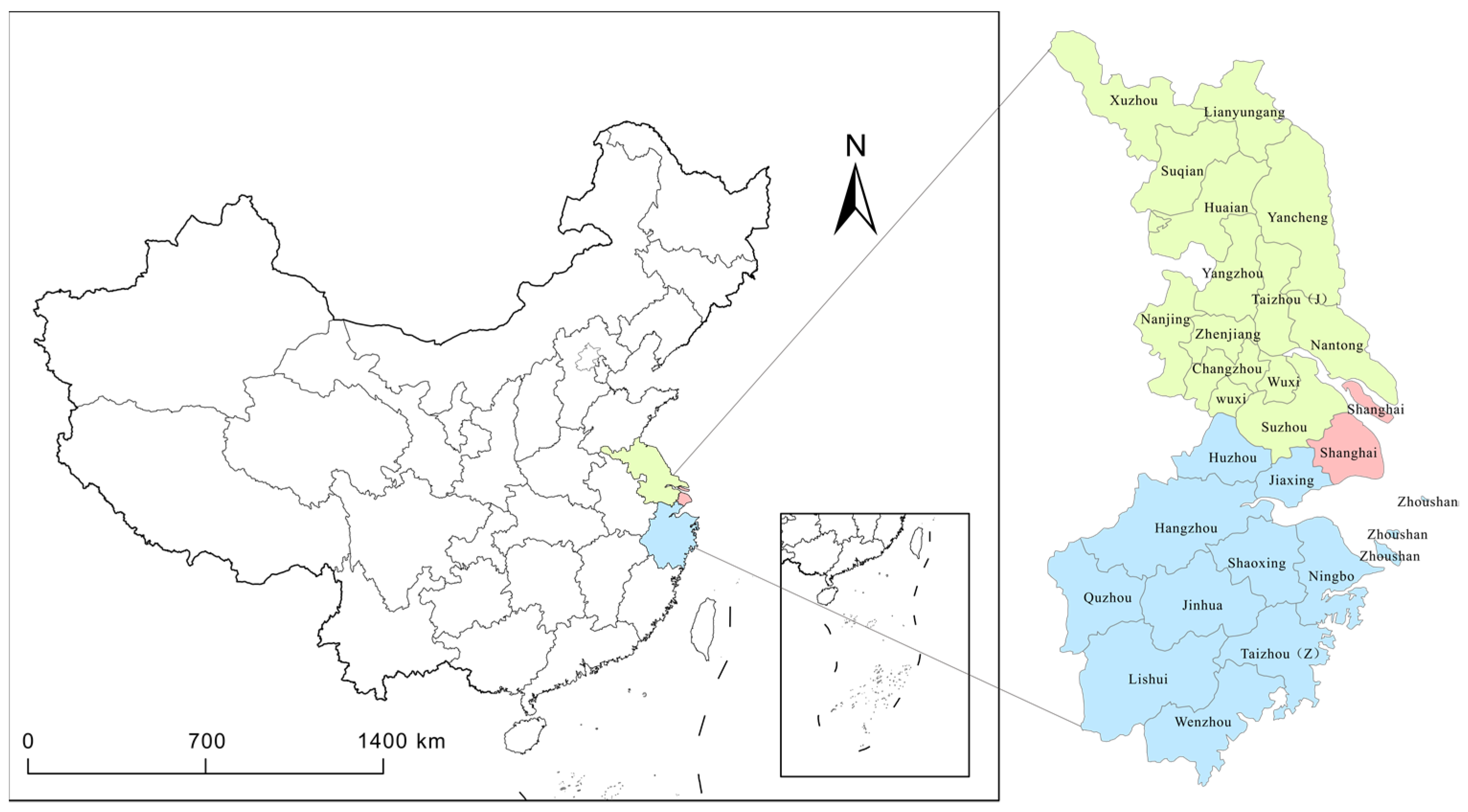
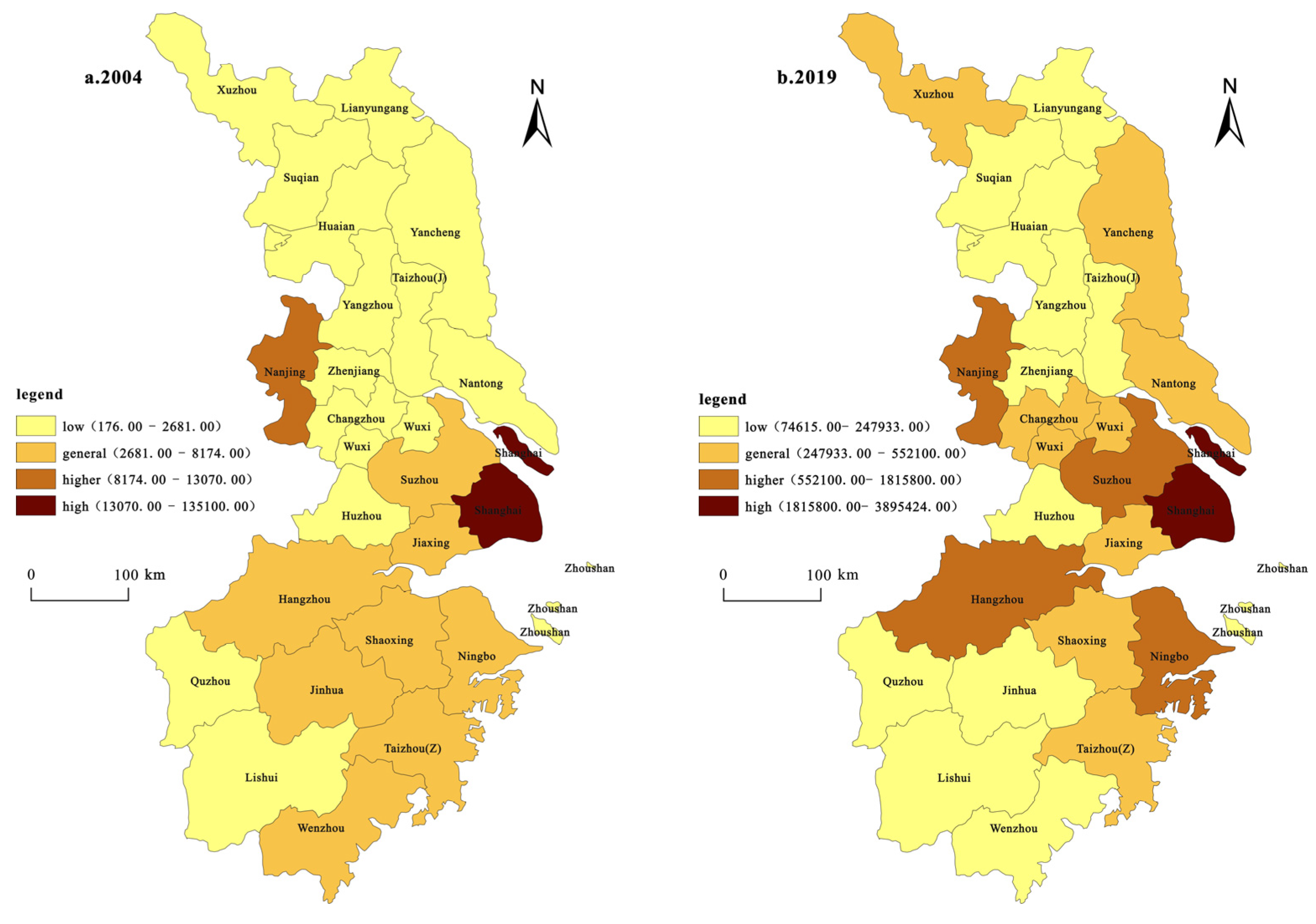
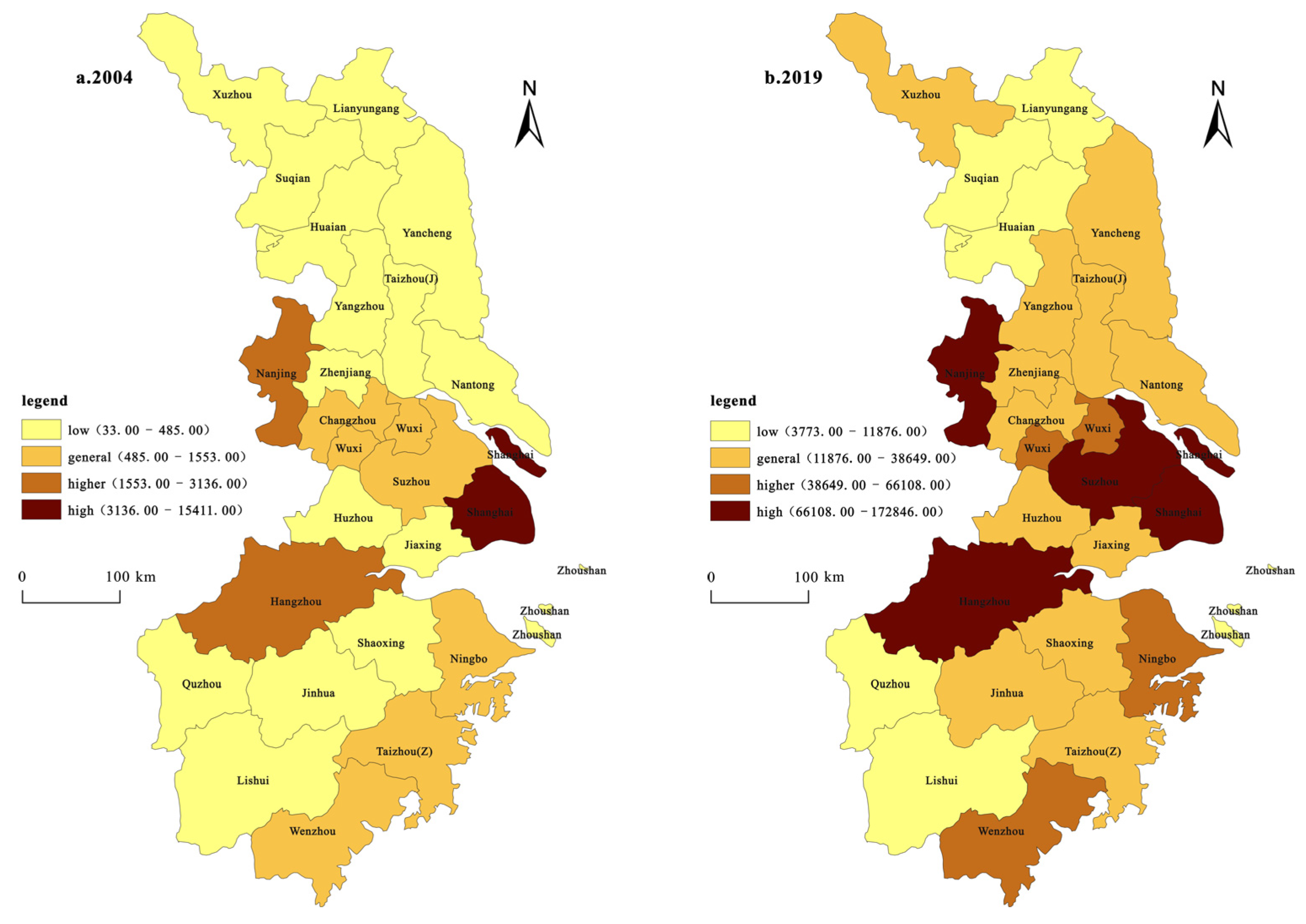
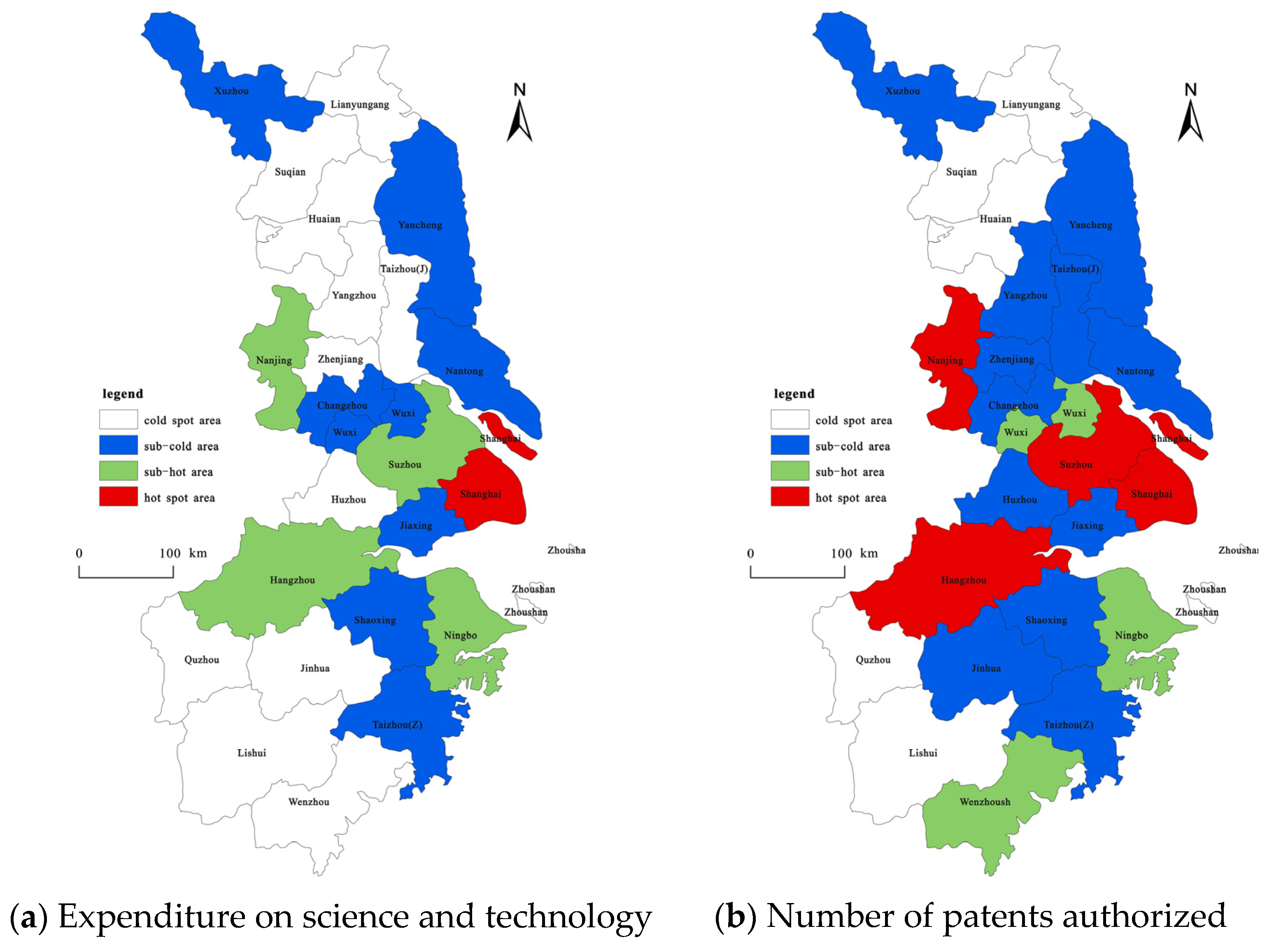

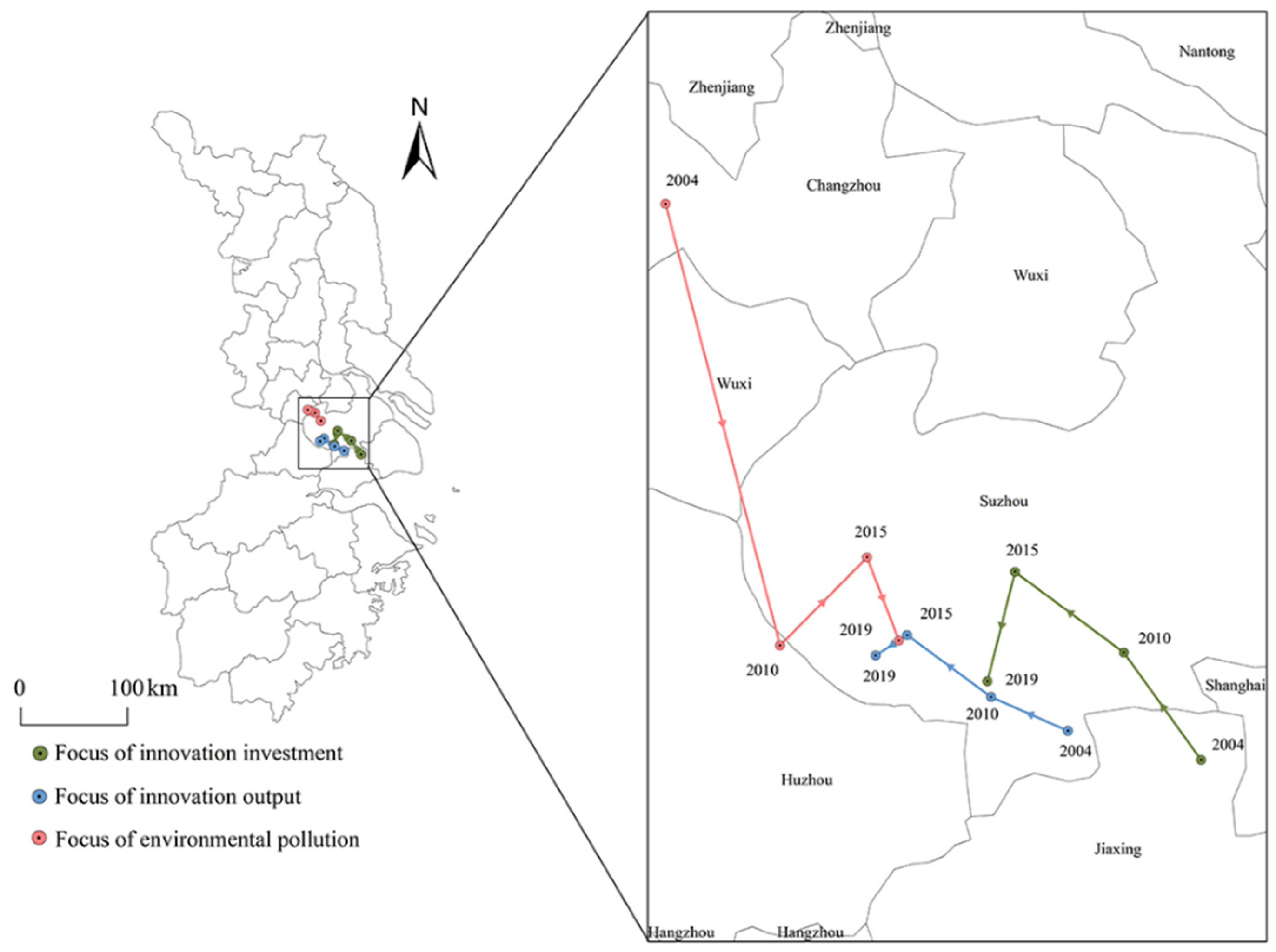
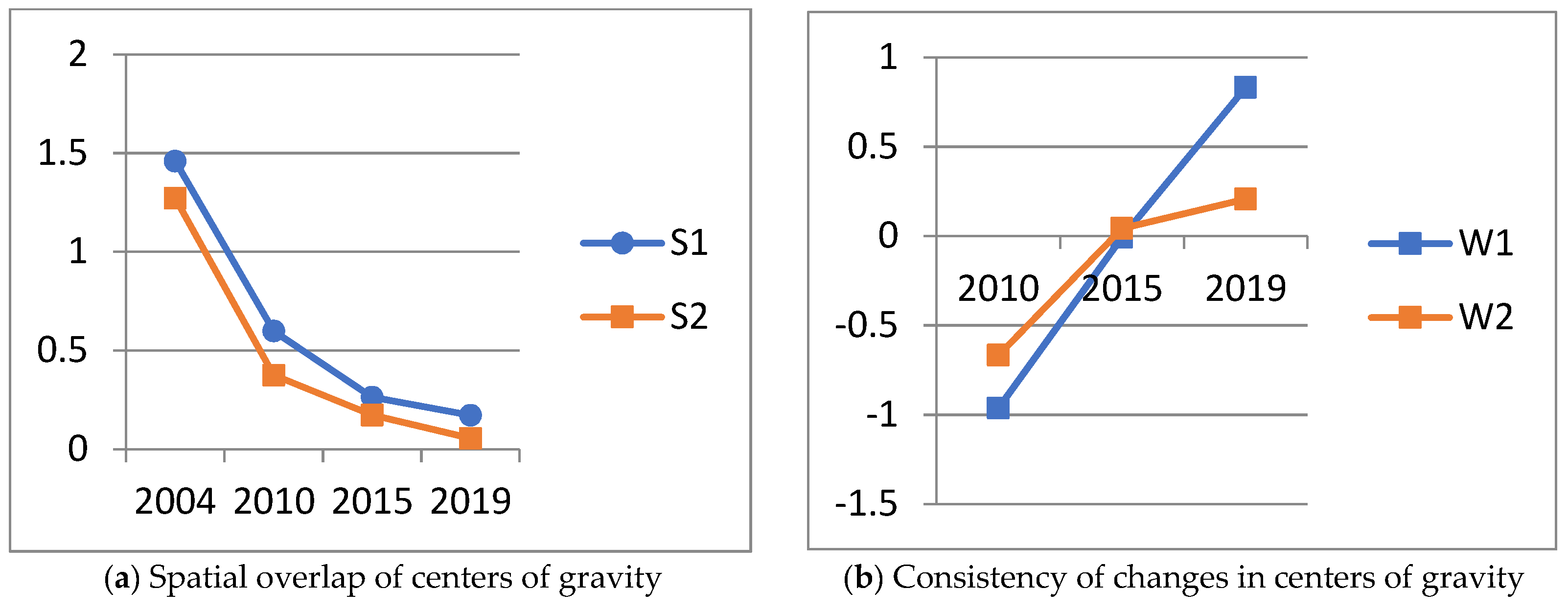
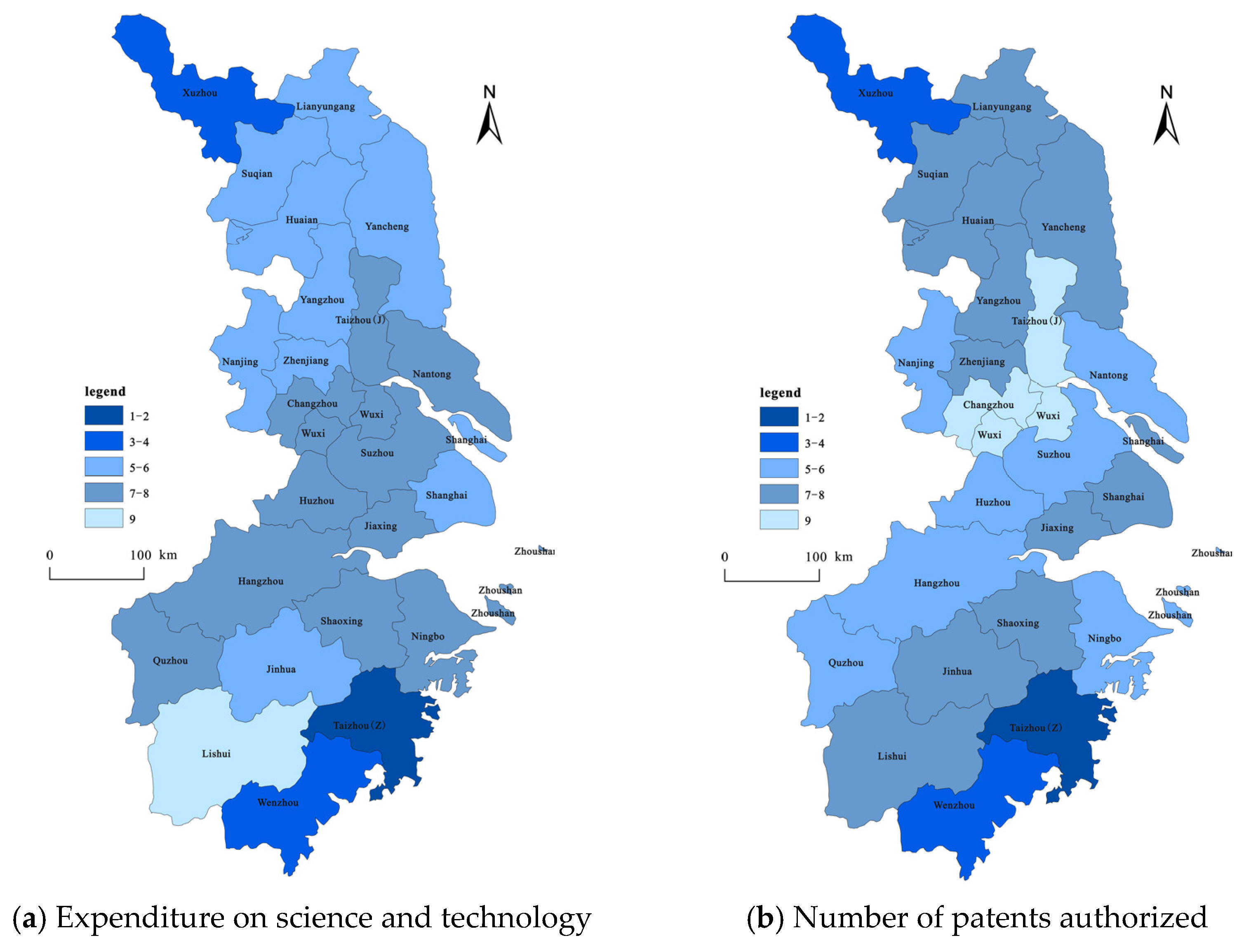
| Influencing Factors | Representative Indicators (Unit) |
|---|---|
| Industrial structure | Share of secondary sector in GDP (%) |
| Foundations of innovation | Year-end mobile phone subscribers (RMB million)/Revenue from postal services (RMB million) |
| Urban greenery | Greenery coverage in built-up areas (%) |
| Environmental Governance | General Industrial Solid Waste Integrated Utilization Rate (%) |
| Population size | Total population at the end of the year (10,000) |
| FDI Factor | Actual amount of foreign investment used in the year (USD million) |
| Investment in innovation | Expenditure on science and technology (RMB million) |
| Innovation output | Number of patents granted (pieces) |
| Influencing Factors | Gray Correlation | Sequence |
|---|---|---|
| Share of secondary sector in GDP | 0.5289 | 1 |
| General Industrial Solid Waste Integrated Utilization Rate | 0.4602 | 2 |
| Total population at the end of the year | 0.4591 | 3 |
| Greenery coverage in built-up areas | 0.4568 | 4 |
| Actual amount of foreign investment used in the year | 0.336 | 5 |
| Number of patents granted | 0.281 | 6 |
| Expenditure on science and technology | 0.2635 | 7 |
| Revenue from postal services | 0.2546 | 8 |
| Year-end mobile phone subscribers | 0.1863 | 9 |
Publisher’s Note: MDPI stays neutral with regard to jurisdictional claims in published maps and institutional affiliations. |
© 2022 by the authors. Licensee MDPI, Basel, Switzerland. This article is an open access article distributed under the terms and conditions of the Creative Commons Attribution (CC BY) license (https://creativecommons.org/licenses/by/4.0/).
Share and Cite
Zhang, J.; Li, H.; Jiao, G.; Wang, J.; Li, J.; Li, M.; Jiang, H. Spatial Pattern of Technological Innovation in the Yangtze River Delta Region and Its Impact on Water Pollution. Int. J. Environ. Res. Public Health 2022, 19, 7437. https://doi.org/10.3390/ijerph19127437
Zhang J, Li H, Jiao G, Wang J, Li J, Li M, Jiang H. Spatial Pattern of Technological Innovation in the Yangtze River Delta Region and Its Impact on Water Pollution. International Journal of Environmental Research and Public Health. 2022; 19(12):7437. https://doi.org/10.3390/ijerph19127437
Chicago/Turabian StyleZhang, Jianwei, Heng Li, Guoxin Jiao, Jiayi Wang, Jingjing Li, Mengzhen Li, and Haining Jiang. 2022. "Spatial Pattern of Technological Innovation in the Yangtze River Delta Region and Its Impact on Water Pollution" International Journal of Environmental Research and Public Health 19, no. 12: 7437. https://doi.org/10.3390/ijerph19127437
APA StyleZhang, J., Li, H., Jiao, G., Wang, J., Li, J., Li, M., & Jiang, H. (2022). Spatial Pattern of Technological Innovation in the Yangtze River Delta Region and Its Impact on Water Pollution. International Journal of Environmental Research and Public Health, 19(12), 7437. https://doi.org/10.3390/ijerph19127437






